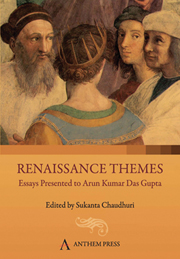Book contents
- Frontmatter
- Contents
- Preface
- List of Contributors
- Arun Kumar Das Gupta
- The Renaissance God as Man of Letters
- Ramist and Senecan Elements in Joseph Hall's The Art of Divine Meditation
- Hypocrite Lecteur: Reading on the Early Modern Stage
- Vertigo
- Folly and Androgyny: Shakespeare's King Lear
- ‘Fatal Visions’ in Macbeth
- The Miltonic Dissimile: Language and Style in Paradise Lost, Book 4
- ‘A Moving Grave’: Positioning Samson Agonistes
- Plate section
Folly and Androgyny: Shakespeare's King Lear
Published online by Cambridge University Press: 05 March 2012
- Frontmatter
- Contents
- Preface
- List of Contributors
- Arun Kumar Das Gupta
- The Renaissance God as Man of Letters
- Ramist and Senecan Elements in Joseph Hall's The Art of Divine Meditation
- Hypocrite Lecteur: Reading on the Early Modern Stage
- Vertigo
- Folly and Androgyny: Shakespeare's King Lear
- ‘Fatal Visions’ in Macbeth
- The Miltonic Dissimile: Language and Style in Paradise Lost, Book 4
- ‘A Moving Grave’: Positioning Samson Agonistes
- Plate section
Summary
Thy tears are womanish, thy wild acts denote
The unreasonable fury of a beast
Unseemly woman in a seeming man […]
[Romeo and Juliet, 3.3.109–11]Critical work on the cultural construction of madness and folly has sensitized us to its gendered dimension. It has demonstrated how the binaries of reason and unreason, wisdom and folly both construct gender categories, and how folly and irrationality are themselves gendered and sexualized. The dichotomies of passion and reason, nature and culture, formlessness and form inflect the male–female binary, creating the stereotypes of irrational, instinctual and unstable women and rational, civil and balanced men. Western discourses of folly frequently conceive it in terms of unbridled female sexuality, just as discourses on women represent them as irrational and foolish.
In classical thought, folly is frequently associated with a feminized sexuality that is savage and transgressive. Christianity reinforces the connections between folly, sexuality and woman in the Fall myth. In Galenic medicine, women's bodies are conceived as cold and moist, controlled by fluids such as menses, milk, ‘female seed’, which make them physiologically and psychologically unstable. Guided by the motions of an unpredictable, ‘wandering’ womb rather than by reason, women are also susceptible to lunar and other external influences, which cause demoniac possession and psychosomatic female maladies such as hysteria and green-sickness.6 In medieval literary representations, Folly is usually represented as a Vice, associated with sexually dissolute behaviour.
- Type
- Chapter
- Information
- Renaissance ThemesEssays Presented to Arun Kumar Das Gupta, pp. 80 - 97Publisher: Anthem PressPrint publication year: 2009



